 Picture source: Mike Kemp
Picture source: Mike Kemp
I feel I should apologise for the flurry of posts from OpenFalklands in recent days. But can you blame me with everything happening at warp speed in the Falklands? That has to be a good thing?
I have been asked to comment on Sure’s surprising proposal to probably offer two new broadband plans with no quotas attached. This is a long post, as I felt I needed to explain all the technical terms before discussing the proposed plans. To be clear, there has been no commitment to launch these two plans by Sure.
Ed’s Note: I must clarify that I have no insider knowledge of Sure’s methods for delivering these plans. My comments are speculative but hopefully useful and only reflect my personal opinions.
This is what the presenter said about the two proposed new plans:
“…one of the things that we understand you as a community want is faster broadband. And a more reliable service at a lower cost. And one of the other big aspects of this is the fact that today broadband is not unlimited. So we want everyone to be able to get unlimited broadband going forward. …and these would replace all of the existing broadband plans that we have in place today. So there’s two plans. And they’re both unlimited. The first plan is for £50 a month for unlimited data. And that goes up to a speed of 5Mbps. The second plan is for £115 a month. It’s also for unlimited data. And it would be to speeds of up to 15Mbps. So a massive increase in the speed of 5 megabits per second. A massive change from where we are today. A big improvement in terms of faster speeds. It removes all of the need to do stuff, for example, beyond midnight. Because the plans will be completely unlimited. We’ve been working extremely hard to find the solution that can bring this about in terms of enabling and ensuring there’s enough capacity to be able to deliver this new service. So it’s faster. It’s lower cost. And it’s unlimited.”
“We have a really strong plan to bring faster, lower-cost broadband for all. So that’s unlimited for all. And then a direct-to-customer LEO solution.”
“Now there’s more capacity available to us, and so we can offer it.”
How the audience received this surprising announcement in the Chamber of Commerce presentation can be summed up in the eloquent comments made by the Deputy Editor of Penguin News after their Interview with Sure Falkland Islands. I’m not sure why the emphasis was placed on increased speed when the plans are slower. The presenter was not talking about the lower latency OneWeb service at the time.
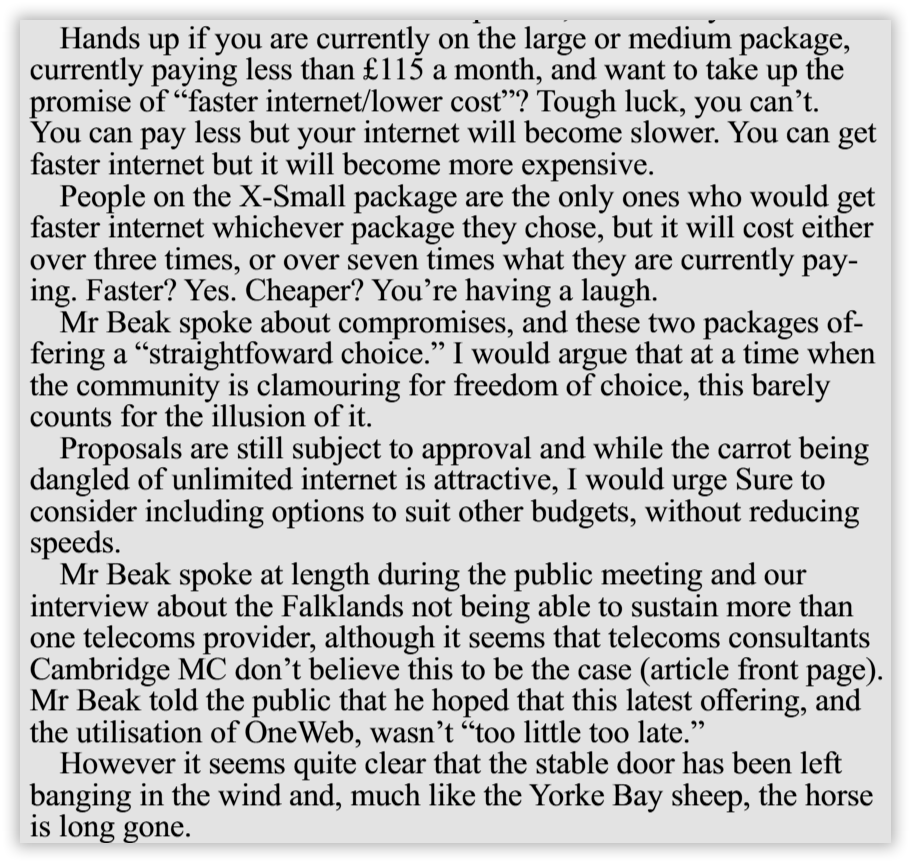 Source: March 28th Penguin News
Source: March 28th Penguin News
First, let’s address the subject of satellite capacity.

There is no ultimate GEO satellite capacity that can fully meet the islands’ aggregate demands
No level of GEO satellite capacity can always meet the islands’ needs, as those needs are constantly evolving. Data-intensive activities like streaming, gaming, and cloud computing demand higher speeds as technology advances. The increasing number of connected devices in households also strains bandwidth, and shared networks often slow down during peak hours. Additionally, limitations imposed by ISPs, network congestion, and emerging technologies such as AI-driven applications will continue to drive higher bandwidth demands. What feels fast today may no longer suffice tomorrow, making the idea of a ‘perfect’ internet speed an ever-moving target.

What is the current capacity of Sure’s Intelsat GEO stationary satellite?
Satellite capacity has always been highly limited due to its high cost, and the exact capacity has never been accurately provided in the public domain. The last objective public information specifying the Intelsat satellite(s) capacity was seen in 2019.

The graph below shows how the capacity increased dramatically from 2004 to 2020, as clearly displayed on the logarithmic Y-axis.
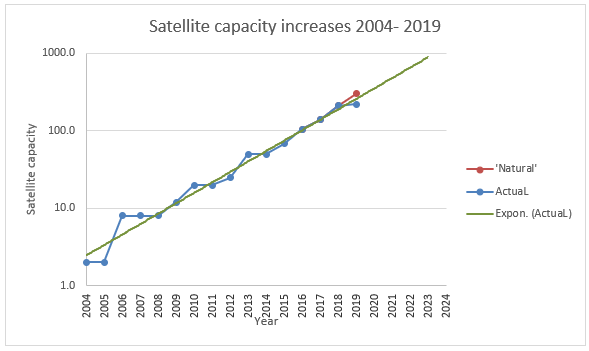 Falkland Islands satellite capacity over time (Actual data)
Falkland Islands satellite capacity over time (Actual data)
Since 2019, the satellite’s capacity has increased due to the doubling of its capacity, paid for by the Falkland Islands Government. There was a further increase of 74% in October 2023 with the addition of the second Intelsat dish (with capacity now divided between the 9 and 11-meter dishes) and further undefined increases a few days before the Starlink Select Committee’s first meeting in 2024. The recent presentation hinted that Sure had increased capacity further. I imagine that Intelsat’s capacity costs have been reduced significantly with the threat of Starlink use in the islands.
The current estimate of Intelsat satellites’ capacity is that it is around 2,000 Mbps. This could be increased if some of OneWeb’s capacity could be added.

Before diving into the details of the new unlimited plans, it’s important first to clarify the terminology commonly used in broadband services. These terms can often be used without much thought, but understanding them is essential.
Fair Usage Policy
A Fair Usage Policy is a set of guidelines enforced by an Internet Service Provider (ISP) to ensure that all users get equitable access to network resources at all times. It is designed to prevent excessive bandwidth consumption by a small number of users, which could negatively impact the experience of others or cause congestion caused by an overloaded GEO satellite connection in the case of the Falkland Islands. Downloading operating system updates has consistently challenged the islands’ residents.
Contention Ratio (CR)
Contention ratio is a term used to describe the number of users sharing a fixed amount of bandwidth. It represents the potential level of competition for available satellite capacity at any given time.
For example, if an ISP offers a connection with a 50:1 contention ratio, this means that, theoretically, up to 50 users share the same capacity on the satellite. The higher the contention ratio, the more users share the same resources, which can lead to reduced speeds, additional latency and performance, especially during peak usage when many users are online.
Contention Ratios adopted by an ISP depend on the type of applications being used by its users, for example, For web browsing, emails, social media, and light streaming, ISPs can oversubscribe significantly, thus a CR used would be in the range of 20:1 to 50:1. For customers using video streaming (Netflix, YouTube, etc.), which is bandwidth-intensive, requires a lower CR for the best Quality of Experience such as 10:1 to 20:1.
Typically, an ISP uses a single contention ratio for its entire network.
Quality of Experience (QoE)
How do ISPs enforce a Fair Usage Police?
Multiple Internet access PLANs
At risk of stating the obvious, one of the core ways an ISP uses to prevent congestion and enable a successful Fair Usage Policy is to offer a wide range of plans, from low-cost to high-cost. Low-cost plans provide low download speeds, while high-cost plans provide high download speeds. Of course, these address customers’ affordability needs as well.
Usage Quotas and data usage caps
A usage quota limits the amount of data a user can consume within a specific period, such as per month. ISPs implement these quotas to manage network resources efficiently and ensure fair access for all users.
The primary purpose of usage quotas is to prevent excessive use by a few users that could degrade service quality for others. They also encourage users to upgrade to higher-tier plans with more data and help reduce network congestion by discouraging excessive downloads and uploads.
ISPs enforce usage quotas in different ways. A hard cap means internet access is completely cut off once the limit is reached, as was later experienced in the Falkland Islands, as proposed by the Cartesian paper in 2015. A soft cap allows users to continue using the Internet but at reduced speeds after exceeding their limit. Some ISPs also apply overage charges, where users are billed extra for any data consumed beyond their quota, which was the situation before introducing the hard cap.
To understand the point of quotas better, it should be considered that doubling a quota is equivalent to doubling the number of users using the service, which could significantly increase congestion. If the GEO satellite capacity is doubled, as in 2019, and the quota is doubled simultaneously, this effectively cancels any benefit from a Quality of Experience perspective!

traffic shaping
Traffic shaping, also known as bandwidth management, is a technique used by ISPs to control data flow on their networks by prioritising certain types of traffic over others. This helps ensure a smooth and efficient network experience for all users.
Traffic shaping primarily aims to prevent network congestion by managing heavy traffic loads. It allows ISPs to prioritise time-sensitive applications such as VoIP calls, file downloads online gaming, and video conferencing while throttling bandwidth-intensive activities like peer-to-peer file sharing and video streaming, especially during peak hours.
ISPs implement traffic shaping through different methods. Prioritisation ensures that critical services, such as emergency communications, receive higher priority over less urgent activities. Throttling is another common approach, where the speed of specific applications, users, or data usage beyond a certain threshold is reduced to maintain overall network performance. A further but stronger method is to discard packets leading to multiple retries.
This explains why the islands’ broadband service significantly slows down at times of peak congestion, such as at the end of the month. It is generally not the global Internet slowing down, but the result of local Traffic Shaping. The picture below shows the concept graphically

Sure often claims that the satellite link is never congested, which is probably correct. A properly managed network should always be able to provide a Fair Usage Service even though it may be excessively slow and unreliable at times. All ISPs worldwide use this approach.
This can be seen in the picture below, taken from the 2015 Cartesian report, based on a graph created by Sure. Of course, demand is much higher at night during the free period than during the day. The red line was the satellite capacity of 68Mbit/s in 2014.
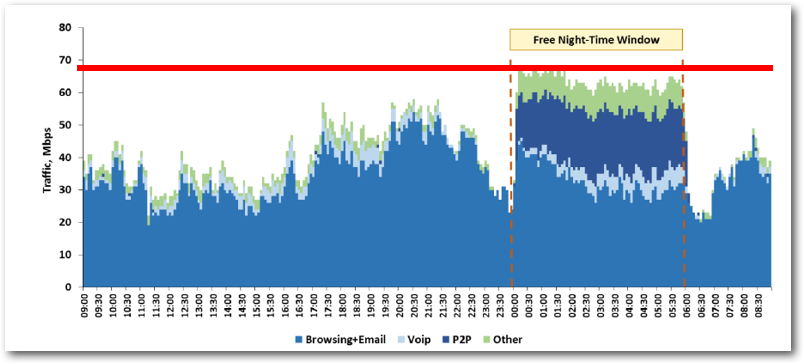

What are the current plans that could be replaced?
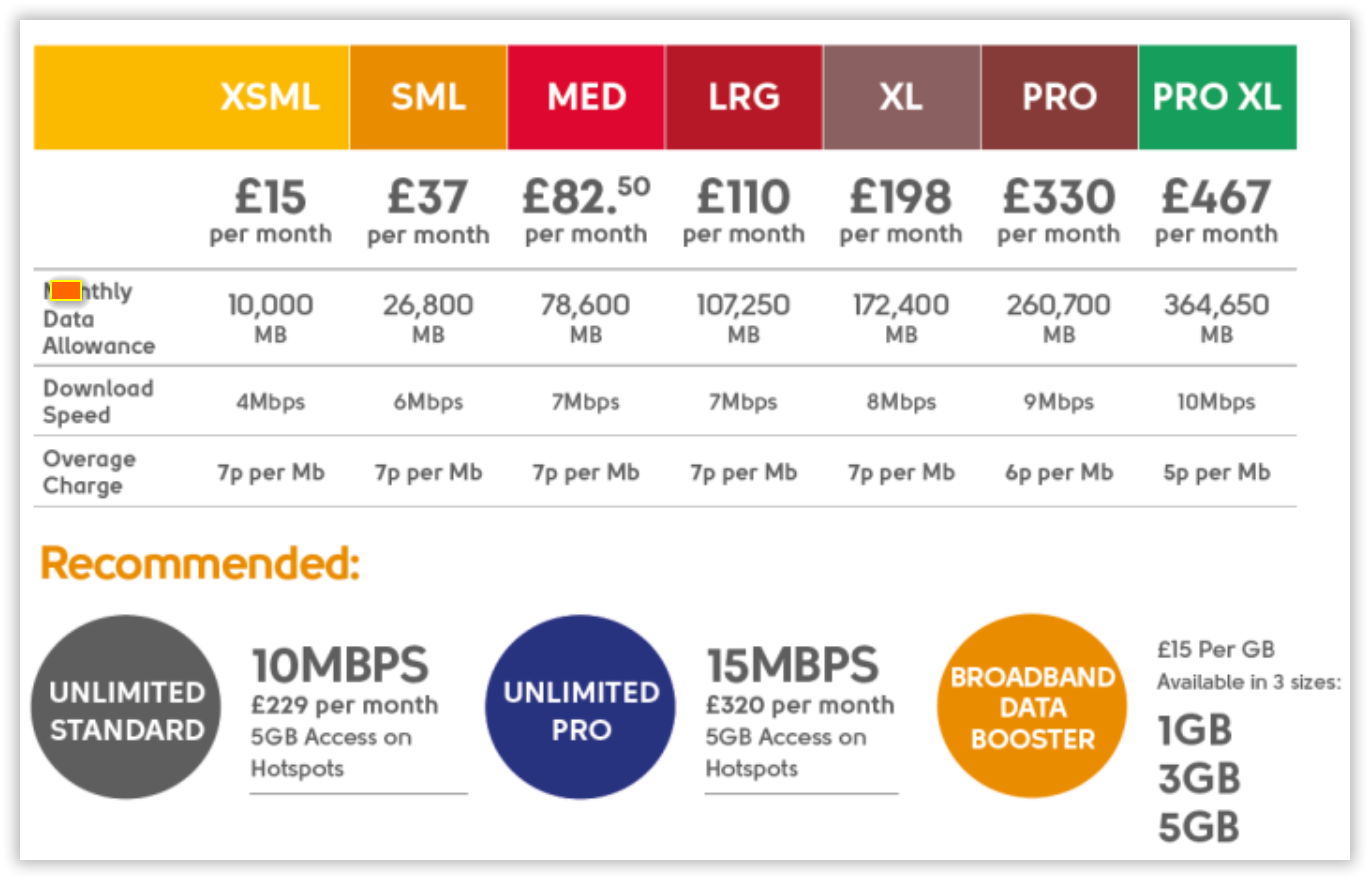
The current plan lineup appears to be a product manager’s nightmare, burdened by a confusing assortment of options that are difficult to navigate. A rationalisation and simplification of these plans would undoubtedly be a welcome improvement.

Sure proposed the new “unlimited” plans in the March 2015 presentation.
It has taken some time to get here, but let’s talk about the two new plans.
“The first plan is for £50 a month for unlimited data. And that goes up to a speed of 5Mbps. The second plan is for £115 a month. It’s also for unlimited data. And it would be to speeds of up to 15Mbps. So a massive increase in the speed of 5 megabits per second. A massive change from where we are today. A big improvement in terms of faster speeds”.
Sure’s ability to propose unlimited broadband service was justified by the comment:
“there is much more capacity available coming from our satellite providers, who we obviously rely on for connectivity to the Falkland network.”
Sure, the Falkland Islands has deliberately lowered the maximum download speeds to be able to introduce quota-free, unlimited services.
Sure is stuck between a rock and a hard place with the introduction of unlimited services, i.e., it needs to balance QoE while maintaining a workable Fair Usage Policy – a challenge all ISPs must manage.
The most significant cause of my concern is that the GEO satellite still has a restricted capacity of 2 Gbps that several thousand users are sharing.

Performance Calculations
So would the new services hold up with no quotas being implemented with the existing satellite capacity? The calculations needed to answer this question are very complicated. No public information is available, so these calculations are based on best-effort speculation and my opinion. However, with the approach taken, anyone can play with the numbers to their heart’s content and have fun.
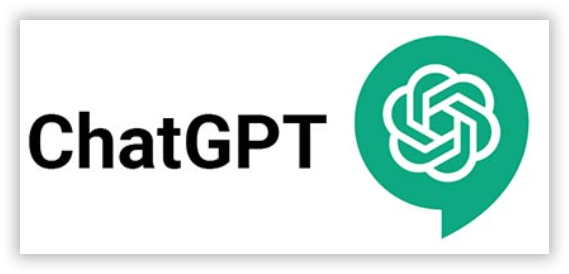 This is 2025, and AI can help with the maths without including the extensive calculations in this post. All readers need to do is ask ChatGPT to undertake the theoretical calculations based on the parameters you supply. I have assumed the following parameters for this post. Of course, I do hope that ChatGPT has got its calculations right!
This is 2025, and AI can help with the maths without including the extensive calculations in this post. All readers need to do is ask ChatGPT to undertake the theoretical calculations based on the parameters you supply. I have assumed the following parameters for this post. Of course, I do hope that ChatGPT has got its calculations right!
Number of users: In 2017, Sure had approximately 800 customers using its bronze and silver services and 900 using its gold service. Let’s assume that this has increased by 10% in the intervening years. Therefore, 990 users will choose the 5 Mbps plan and 1000 will use the 15 Mbps plan. Of course, the split between these two plans might be anyone’s guess, so your ideas are as good as mine! The calculations do not include businesses, MPA personnel, or FIG intranet users.
Satellite capacity: We can assume a GEO satellite capacity of 2,000 Mbps.
Contention Ratio: We can use a CR of 10:1 for customers using SD streaming services such as Netflix or YouTube or downloading large files, and 20:1 for web browsing.
This is the question I gave to ChatGPT. Any significant increase in any one of the parameters could lead to network congestion that would degrade QoE.
Run calculations with 3 scenarios – Contention Ratio = 20:1; Contention Ratio = 15:1; and finally Contention Ratio = 10:1. Use a backbone satellite capacity of 2000 Mbps. 990 customers expect a download speed of 5 Mbps and 1000 customers expect a download speed of 15 Mbps. 80% of the total customer base is online at any time. Will users experience congestion? Show the calculations.
In Scenario 1, with a contention ratio of 20:1, the adjusted bandwidth demand is 997.5 Mbps – the demand is well within the available bandwidth. Therefore, there will be no congestion in this scenario.
In Scenario 2, where the contention ratio is 15:1, the adjusted bandwidth demand increases to 1330 Mbps – this demand is still comfortably within the available bandwidth. As a result, there will be no congestion in this case either.
Finally, in Scenario 3, with a contention ratio of 10:1, the adjusted bandwidth demand reaches 1995 Mbps – but still within the limit. Therefore, there will be no congestion even in this scenario, which is getting very close to the need to manage congestion!
With the calculations just carried out, what would be the optimal contention ratio to avoid congestion?
To avoid congestion, the optimal contention ratio should be 14:1.
This ensures that the adjusted demand does not exceed the 2000 Mbps capacity, as the demand at this ratio would be exactly 2000 Mbps. Any contention ratio higher than 14:1 would lead to congestion, while lower ratios (like 15:1 or 10:1) would also avoid congestion but might lead to underutilization of available capacity.
It is interesting to note that if the two plans’ download speeds were increased to 10 Mbps and 20M Bps in Scenario 3, the adjusted bandwidth demand increases to 2990 Mbps, and there will be excessive congestion in this scenario.. This could indicate why Sure Falkland Islands was forced to downgrade the proposed download speeds.
Please remember that only Sure network architects can undertake this sort of calculation with any level of confidence, as it will be based on empirical measurement data. However, playing around with the numbers is fun for us ‘amateurs’.

Conclusions
My primary concern was whether Sure could effectively balance offering an unlimited, quota-free service while supporting many concurrent users with diverse application needs with a good QoE.
Encouragingly, my rough calculations – assisted by ChatGPT – suggest the system could function as needed. However, peak evening streaming times, like when most users watch Netflix, could still cause congestion and service degradation. However, these theoretical estimates remain speculative, and any significant changes in key parameters could still lead to network congestion.
Ultimately, if these plans are introduced, only time will tell whether they truly meet customer expectations for QoE. Delivering a seamless experience remains a significant challenge for any ISP, let alone relying on a satellite connection with limited capacity.
After years of writing about this topic on OpenFalklands, I’m thrilled to see Sure Falkland Islands finally prioritising QoE by reducing maximum download speeds, which is a clear step in the right direction. But I can’t help but wonder – couldn’t this have been proposed years ago?

Chris Gare, OpenFalklands April 2025, copyright OpenFalklands

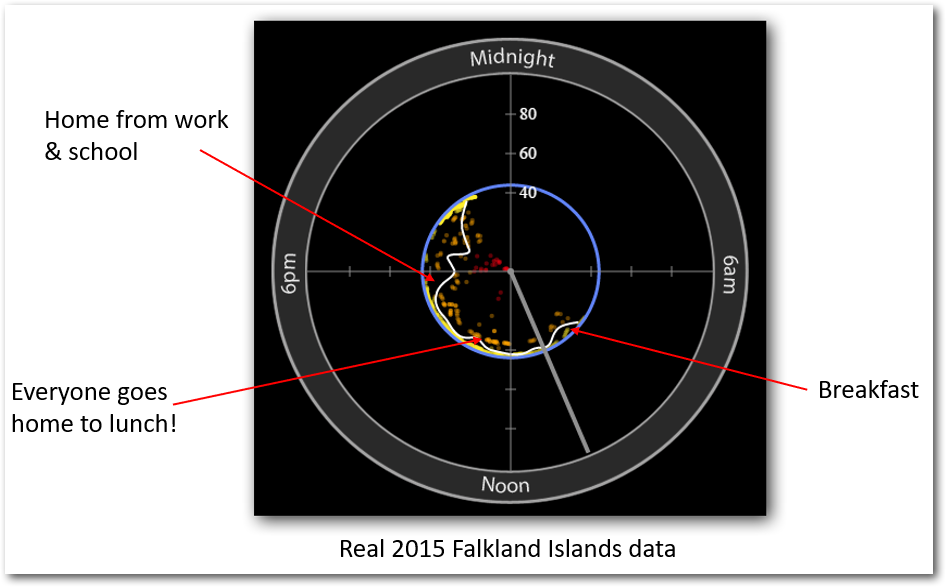
Interestingly, I’ve heard from a couple of sources that that the total Intelsat satellite capacity of the two big dishes is around 2.5Gbps. If that is a more accurate estimate of capacity then that will improve the Quality of Exerience of users of the two no-quota services if they are launched.
Why cannot they just offer 1 package,